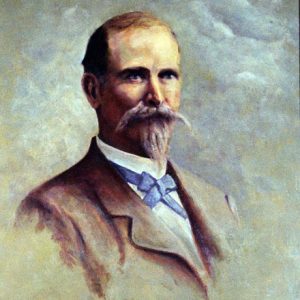calsfoundation@cals.org
Helena Expedition (March 5–12, 1863)
aka: St. Francis River Expedition
aka: Little River Expedition
| Location: | St. Francis, Cross, and Poinsett Counties |
| Campaign: | Expedition from Helena up the St. Francis and Little Rivers, and Skirmish at Madison, Arkansas |
| Dates: | March 5–12, 1863 |
| Principal Commanders: | Colonel Powell Clayton, Expedition Commander (US); Unknown (CS) |
| Forces Engaged: | Twenty-fourth Indiana Volunteer Infantry, Third Iowa Cavalry, and a section of the Second Ohio Battery (US); Unknown (CS) |
| Estimated Casualties: | 1 wounded (US); 4 killed, 46 prisoners (CS) |
| Result: | Union victory |
Traveling up the St. Francis River from Helena (Phillips County) on March 5, 1863, Colonel Powell Clayton’s command moved into the Little River in Poinsett County, dispersing Confederates along the way and seeking the steamer Miller. The Union forces engaged the Confederates traveling upriver at Madison (St. Francis County), found the sunken Miller, and engaged Confederates north of, and again in, Madison while traveling back downriver. Overall, Clayton’s expedition took a number of prisoners and supplies that Confederates could not afford to lose in this region.
With a firm hold on Helena, state-level Union leadership focused on the wearing down of Confederate resistance in Arkansas, but commanders in occupied cities like Helena had to remain aware of the immediate area. This required launching raids into northeastern Arkansas from Helena to clear out Confederate regulars, guerrillas, and partisan bands that attempted to infiltrate the region. On March 5, 1863, Col. Clayton, Fifth Kansas Cavalry, left Camp Vandever at Helena with a force consisting of fifty men from the Twenty-fourth Indiana Volunteer Infantry, twenty-five from the Third Iowa Cavalry, and a section of the Second Ohio Battery. Boarding the steamer Hamilton Belle, Clayton was ordered to ascend the St. Francis River up to and beyond the mouth of the Little River, scattering or destroying all Confederate forces in the region and capturing the steamer Miller.
Clayton’s force traveled up the St. Francis River without incident until arriving at Madison, the location of the intersection of the St. Francis River and the Memphis and Little Rock Railroad. Able to approach the town undetected due to the angle of the river, the steamboat was approaching the dock before being discovered. Surprising a small, unidentified Confederate force there, the Union force scattered the Rebels, who left everything in their haste. Clayton quickly landed his troops, and they caught twenty-seven of the estimated seventy-five surprised Confederates and all of their abandoned equipment.
After securing the supplies in Madison, Clayton continued his quest to locate the Miller. Sailing up the Little River, he found the vessel sunk. Unable to do anything with it, Clayton prepared to return south. Believing that the Confederates would have concentrated forces at key points on the St. Francis to block his return, he seized sixty-four cotton bales to construct a protective barrier on the boat. Sailing south, Clayton’s command confiscated a number of supplies being illegally traded near the mouth of the Little River, including salt, flour, quinine, and percussion caps. Continuing on to Wittsburg (Cross County), the Union troops captured fifteen hogsheads of sugar and received intelligence regarding Confederate traps downriver.
Just two miles north of Madison, Clayton observed cotton sitting on the banks in a manner used to flag ships for transport to market. Considering this a possible trap, Clayton ordered the Second Ohio to fire a few artillery rounds in the brush near them. As the ship approached the location of the cotton, Clayton observed horses on top of the hill and knew it was a trap. He ordered the Second Ohio to fire canisters into the brush, and the Confederates sheltering there scattered. After landing the vessel, Clayton sent his men after the Confederates. In the short skirmish, four Confederates were killed, and Lieutenant William C. Niblack, Third Iowa Cavalry, received a grievous chest wound.
Returning to the steamer, the Union forces continued downriver toward Madison to discover a chain linked between the pylons there. Landing before the obstacle, Clayton disembarked troops to protect the vessel and sent a work party forward to remove the chain. During the short skirmish that ensued, one Confederate prisoner was taken. Once the obstacle was cleared, the Hamilton Belle continued south. Immediately, the steamer took fire from the river bank. Using his artillery, Clayton scattered the enemy forces, ending the combat operations of this expedition. The force arrived back in Helena on March 12.
Overall, Clayton’s expedition had a sizeable impact in the St. Francis River valley. With minimal loss, the Federals kept thirty-six of the forty-six prisoners taken, releasing ten due to the lack of supplies necessary to hold them before returning to Helena. Of the sixty-four bales of cotton seized, Clayton allowed for sixty of these to be available for reclaim at the end of the expedition by the original owners, keeping the four used during the trap above Madison. Additionally, a number of other items were removed from the hands of the Confederates, including fifteen hogsheads of sugar, thirteen barrels of salt, two barrels of flour, 500 pounds of bacon, twenty-three horses, three mules, eighty ounces of quinine, thirty firearms, and 500 percussion caps.
The Helena Expedition exemplifies the nature of the war in northeastern Arkansas after the Union occupation of Helena in 1862. Using their ability to muster steamers, the Federals were able to project power along navigable rivers much more effectively in this region than the Confederates. However, typical of land raids, the number of Federals deployed on many of these raids remained relatively small, and the Confederate units they encountered were usually smaller. Thus, the majority of the engagements that typically occurred in this region after 1862 were small, and many of these skirmishes lacked real strategic value. Comparatively, Clayton’s expedition was rather successful, as it did disrupt Confederate actions and supplies in the St. Francis River valley for a short time.
For additional information:
The War of the Rebellion: A Compilation of the Official Records of the Union and Confederate Armies. Series I, Vol. 22, Part I, pp. 236–237. Washington DC: Government Printing Office, 1891.
Derek Allen Clements
Black River Technical College








Comments
No comments on this entry yet.